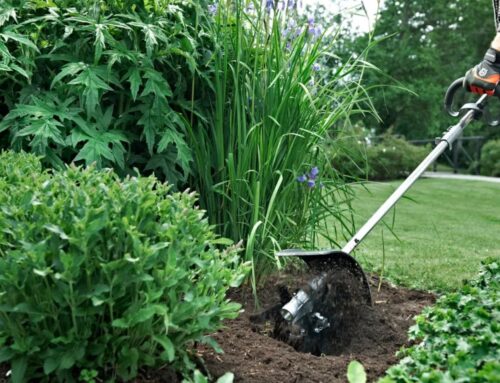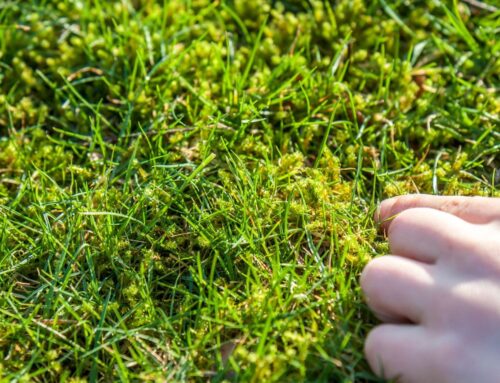
Our Complete Guide to Scarifying a Lawn
A flourishing, green lawn is the dream of many gardeners, but maintaining healthy grass requires more than just regular mowing and watering. One of the most important lawn care practices is scarification, which is a process that removes thatch, moss and debris to promote better air circulation, water absorption, and overall lawn vitality.
This guide will explain everything you need to know about lawn scarification. We will cover why it is essential, how it works, the best time to scarify your lawn in the UK, and provide step-by-step instructions to ensure you do it effectively. We’ll also show you where to find Britain’s best range of scarifiers for sale. So, whether you are intending on just using a rake or looking for the perfect lawn scarifier machine for your needs, this comprehensive guide has you covered.
Understanding Lawn Scarification
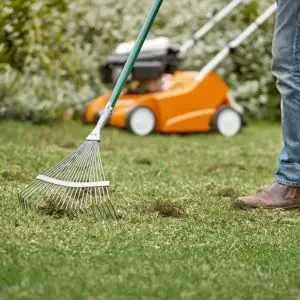 Lawn scarification, also known as grass scarification or simply scarifying, is the process of removing the layers of thatch that build up between the grass blades and soil. If this layer is left unchecked, it prevents essential nutrients, water and oxygen from reaching the grassroots, leading to weak and patchy lawns.
Lawn scarification, also known as grass scarification or simply scarifying, is the process of removing the layers of thatch that build up between the grass blades and soil. If this layer is left unchecked, it prevents essential nutrients, water and oxygen from reaching the grassroots, leading to weak and patchy lawns.
Scarifier – What Does it Do?
Scarification is typically carried out using a scarifier, which is a garden machine powered by either batteries, electricity or petrol. These machines cut vertically into the lawn, lightly scoring the soil, which encourages healthy grass growth. For those without a scarifier, the same process can be carried out with a rake, though it is much more labour-intensive work.
Why Scarify Your Lawn?
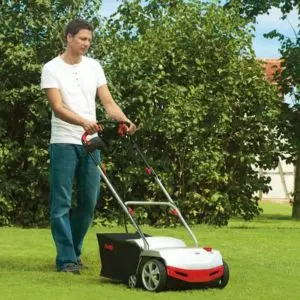 Over time, grass clippings, moss and organic debris accumulate on your lawn, forming a dense thatch layer. This thatch suffocates the grass, preventing it from receiving necessary nutrients. Regular lawn care scarifying improves air circulation, enhances water absorption, prevents disease and pests, and encourages stronger grass growth. Removing moss and thatch gives grass the space it needs to thrive, resulting in a healthier and more vibrant lawn.
Over time, grass clippings, moss and organic debris accumulate on your lawn, forming a dense thatch layer. This thatch suffocates the grass, preventing it from receiving necessary nutrients. Regular lawn care scarifying improves air circulation, enhances water absorption, prevents disease and pests, and encourages stronger grass growth. Removing moss and thatch gives grass the space it needs to thrive, resulting in a healthier and more vibrant lawn.
If moss has taken over your lawn, scarifying can help remove it and create space for new, healthier grass growth. By eliminating this build-up, you allow the grass to receive the oxygen and sunlight it needs to flourish.
The Best Time to Scarify Your Lawn
Timing is crucial for lawn scarification to be effective. The best time to scarify a lawn in the UK is during either spring or autumn. Scarifying during extreme weather conditions, such as the height of summer or winter frost, can cause unnecessary stress to the lawn and hinder its recovery.
Scarifying in Spring
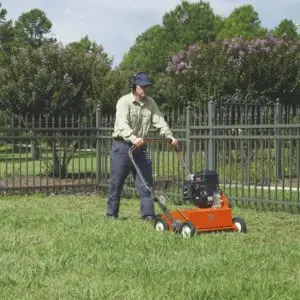 Spring is one of the best times to scarify grass because it is actively growing and will recover quickly. The best months are from March to May, when soil temperatures consistently stay above 10°C. It is also important to ensure the lawn has been mowed at least three or four times since winter before beginning the scarification process. Completing the task in April or May allows the grass to recover rapidly and prepares it for the growing season ahead.
Spring is one of the best times to scarify grass because it is actively growing and will recover quickly. The best months are from March to May, when soil temperatures consistently stay above 10°C. It is also important to ensure the lawn has been mowed at least three or four times since winter before beginning the scarification process. Completing the task in April or May allows the grass to recover rapidly and prepares it for the growing season ahead.
Autumn Lawn Scarification
Lawn scarification when carried out in autumn is beneficial for clearing summer thatch and moss while preparing the lawn for winter. However, it should be carried out lightly to avoid stressing the grass too much before dormancy. The best time for autumn scarification is between late August and October when temperatures are still mild and before the first frost sets in.
Scarifying should be avoided in hot, dry summer months as it can dry out the lawn and cause damage. Similarly, working on a lawn that is too wet can be ineffective and messy. If your lawn is newly seeded, wait at least two to three years before scarifying to avoid disturbing young, delicate grass roots.
How to Scarify Your Lawn
 Scarifying your lawn properly ensures the best results and prevents damage to the grass. Start by mowing your lawn short, ideally to between three and five centimetres. This will make it easier for the scarifier to penetrate the thatch and remove debris more effectively.
Scarifying your lawn properly ensures the best results and prevents damage to the grass. Start by mowing your lawn short, ideally to between three and five centimetres. This will make it easier for the scarifier to penetrate the thatch and remove debris more effectively.
Begin by scarifying in one direction across the lawn. Once the first pass is complete, go over the lawn again at a 45-degree angle to ensure full coverage. Adjust the depth of the scarifier to remove moss and thatch without excessively disturbing the soil.
After scarifying, the lawn will likely look messy, with clumps of thatch and moss covering the surface. Use a rake or a lawn mower with a collection box to remove the debris. This will prevent further build-up and allow the grass to recover more quickly.
Lawn Aftercare
Scarifying can stress the lawn, so proper aftercare is essential. Applying a nitrogen-rich fertiliser immediately after the process will help the grass recover by stimulating its development. Overseeding is also recommended to fill in any bare patches and promote even growth.
 Watering is crucial for recovery, and the lawn should be kept moist for at least two weeks after scarification. If rain is not expected, daily watering may be necessary to ensure the new grass seed establishes itself properly.
Watering is crucial for recovery, and the lawn should be kept moist for at least two weeks after scarification. If rain is not expected, daily watering may be necessary to ensure the new grass seed establishes itself properly.
How Often Should You Scarify?
The frequency of lawn scarification depends on the condition of your lawn. If your lawn has a thick thatch layer exceeding two centimetres, annual scarification is necessary. For moderate thatch build-up, scarifying once every two years should be sufficient. If your lawn is relatively healthy with minimal thatch, a light raking once a year may be all that is needed.
A lawn that is regularly maintained with good mowing and aeration practices may not need frequent scarification. However, if moss and thatch begin to dominate, more regular scarification will be required to keep the grass in optimal condition.
Choosing the Right Scarifier
As you can see, scarifying is an essential part of lawn maintenance that enhances the health and appearance of your grass. By carrying out scarification at the right time and using the appropriate tools, you can enjoy a flourishing, green lawn throughout the year.
Ultimately, choosing the right scarifying tool depends on your lawn size and budget. For smaller lawns, scarifying with a rake may be sufficient, although it does require significant effort and isn’t as effective as using a specialist garden machine.
So, for the most comprehensive thatch removal, why not browse our complete collection of scarifiers for sale? If you have a smaller lawn, be sure to check out our cordless and electric scarifiers. And for larger lawns, you’ll find we have plenty of petrol-powered models with suitable efficiency and power.

